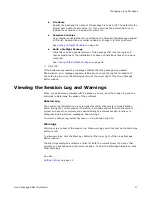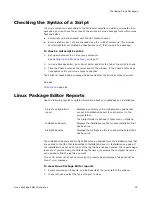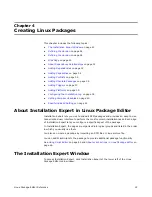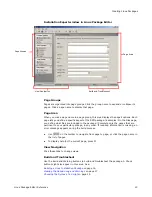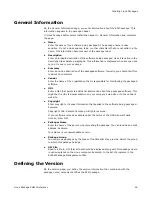
Linux Package Editor Reference
9
Introduction to Linux Package Editor
software packages. A package consists of an archive of files along with information
about the package, including name, version, and description.
Information about all installed packages and the files that they create or change is
stored in the RPM database on the Linux computer. RPM contains a powerful set of query
capabilities to obtain information about packages, such as the files that make up a
package, what files are installed, and which files are configuration or documentation
files.
An RPM file is a package file that contains software that will be installed using RPM.
About the Shell File
The Linux project file (.LPR) compiles to a shell file (.SH), which acts as a “wrapper” to
the RPM and provides additional functionality.
Following is a representation of the compiled shell file.
Warning
Only create the shell file by using the Build Installation Package command. Editing the
shell file manually will cause the installation to fail.
See also:
Building a Linux Installation Package
on page 16
About the $WISEFOLDER Directory
on page 26
Initialization section
Extracts the RPM file
Extracts the contents of $WISEFOLDER
Pre-RPM script
RPM command
rpm -U with additional command-line options that
are defined in the package
Results handling information for:
installation log (used for reporting)
Binary RPM file ...
This is visible in the shell file, but as indecipherable
binary code.
At run time, the RPM is extracted from the shell
file.

















